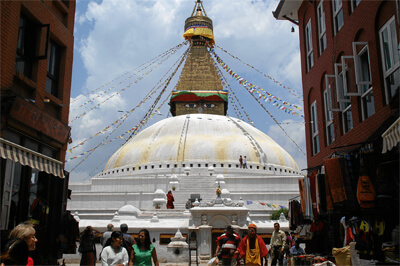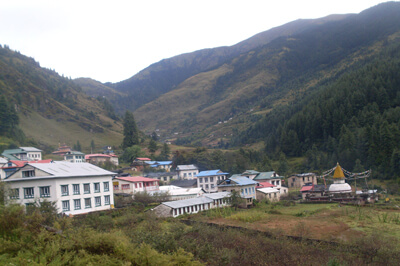About Nepal
AREA: 147,181 sq. kilometers.
ALTITUDE: Varies from 70 meters to 8848 meters.
CAPITAL: Kathmandu.
POPULATION: 1, 84, 91,097
LANGUAGE:
Nepali is the national language of Nepal. Educated people understand and speak English as well.
Religions:
 Religious practices are an important part of the lives of the Nepalese people. Mythologies of various Hindu gods and goddesses abound in this country and cultural values are based on the philosophies of holy books like the Swasthani, Gita, Ramayana etc.
Religious practices are an important part of the lives of the Nepalese people. Mythologies of various Hindu gods and goddesses abound in this country and cultural values are based on the philosophies of holy books like the Swasthani, Gita, Ramayana etc.
Women and children visit neighborhood shrines at dawn to offer worship to the gods. Holding plates of rice, flowers, and vermilion powder, they perform puja by lighting incense, ringing the temple bell, and applying tika, a red paste, on their foreheads. Passers by stop at temples and show their reverence to the gods by spending a few minutes praying. Occasionally, groups of men sit near temples playing music and singing hymns until late night.
In Nepal, Hinduism and Buddhism are the two main religions. The two have co-existed down the ages and many Hindu temples share the same complex as Buddhist shrines. Hindu and Buddhist worshipers may regard the same god with different names while performing religious rites.
Majority of the people here are Hindu. However, people practice some other religions like Islam, Christianity, and Bon. Some of the earliest inhabitants like the Kirats practice their own kind of religion based on ancestor worship and the Tharus practice animism. Over the years, Hinduism and Buddhism have been influenced by these practices which have been modified to form a synthesis of newer beliefs.
As a result, visitors to this country may often find the religious practices in Nepal difficult to follow and understand. But this does not prevent one from enjoying the different traditional ceremonies and rituals of Nepalese culture. It is indeed a totally new experience of religious fervor.
Nepal has a population of more than 22 million people made of different races living in different regions, with diverse culture, Languages and dialects .The Gurungs and Magars live mainly in the west. The Rais, Limbus and Sunuwars inhabit the slopes and valleys of the eastern mid hills. The Sherpas live in the Himalayan region. The Newars constitute an important ethnic group of the capital valley Kathmandu. There are Tharus, Yadavas, Satar, Rajvanshis and Dhimals in the Terai region. The Brahmans, Chhetris and Thakuris are spread generally over most parts of the kingdom.
Geography:
 Nepal has only Hindu Kingdom in the word is located between India and china occupying an area of 147,181sq.km it's length from north -west to south-east is above 800km and it's width varies from 90 km to 230km. Though Nepal is small in size well find different geographical positions and variations in the altitude of different places. It's elevation ranges from 60.mt above sea level to 8848 mt Nepal is geographically divided into three majors regions.
Nepal has only Hindu Kingdom in the word is located between India and china occupying an area of 147,181sq.km it's length from north -west to south-east is above 800km and it's width varies from 90 km to 230km. Though Nepal is small in size well find different geographical positions and variations in the altitude of different places. It's elevation ranges from 60.mt above sea level to 8848 mt Nepal is geographically divided into three majors regions.
Himalayan region:
This region possesses one third of the ethic Himalayan ranges including the eight highest peaks in the world and 1300 other peaks well above 6000mt in height making Nepal proud of it's natural beauty and heritage.
Mountain region:
This region covers 64% of Nepal's total surface area. The Mahabharat range with an altitude of 4877mt. And Chure hills ranging from 135mt to 900mt.
Terai region:
This regions cover 17%of Nepal's total surface area. A major portion of this region is used in farming. This is where most of Nepal's forests and wildlife are found Royal Bengal Tigers, one horned rhinos Crocodiles, Snakes, fresh-water dolphins 350 species of birds etc are all a part of the wildlife found this region.
Time:
Nepal time is 5 hours 45 minutes ahead of GMT and 15 minutes ahead of Indian standard time.
